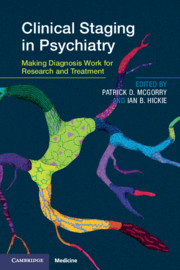Book contents
- Clinical Staging in Psychiatry
- Clinical Staging in Psychiatry
- Copyright page
- Contents
- Contributors
- Foreword
- Acknowledgements
- Section 1 Conceptual and Strategic Issues
- Section 2 Progress with Clinical Staging
- Section 3 Novel Treatment Strategies
- Chapter 11 Novel Biological Treatment Strategies
- Chapter 12 Psychosocial Interventions for Youth Mental Health
- Section 4 Novel Treatment Strategies
- Index
- Plate Section (PDF Only)
- References
Chapter 11 - Novel Biological Treatment Strategies
from Section 3 - Novel Treatment Strategies
Published online by Cambridge University Press: 08 August 2019
- Clinical Staging in Psychiatry
- Clinical Staging in Psychiatry
- Copyright page
- Contents
- Contributors
- Foreword
- Acknowledgements
- Section 1 Conceptual and Strategic Issues
- Section 2 Progress with Clinical Staging
- Section 3 Novel Treatment Strategies
- Chapter 11 Novel Biological Treatment Strategies
- Chapter 12 Psychosocial Interventions for Youth Mental Health
- Section 4 Novel Treatment Strategies
- Index
- Plate Section (PDF Only)
- References
Summary
The identification of people at high risk for future mental disorders is accompanied by the imperative to provide stage-adequate treatments that successfully prevent progression to more severe illness stages. Current evidence-based treatments include psychological and psychosocial treatments on one hand as well as pharmacotherapy. The latter is limited by inadequate efficacy and prominent side effects in many cases, making the discovery of novel biological treatment strategies necessary. Such novel treatments need to be safe, effective, characterised by a benign side effect profile and accessible to young people. In this chapter, emerging biological treatment approaches are reviewed and discussed in regard to their potential impact on early intervention and clinical staging. Substances reviewed here include long-chain omega-3 fatty acids (fish oil), n-acetylcysteine (NAC), cannabidiol and repeated transcranial magnetic stimulation (rTMS) with a particular focus on recent advancements in their application in youth with incipient mental disorders. Finally, research priorities in the field of treatment trials are discussed in this chapter.
Keywords
- Type
- Chapter
- Information
- Clinical Staging in PsychiatryMaking Diagnosis Work for Research and Treatment, pp. 221 - 240Publisher: Cambridge University PressPrint publication year: 2019

